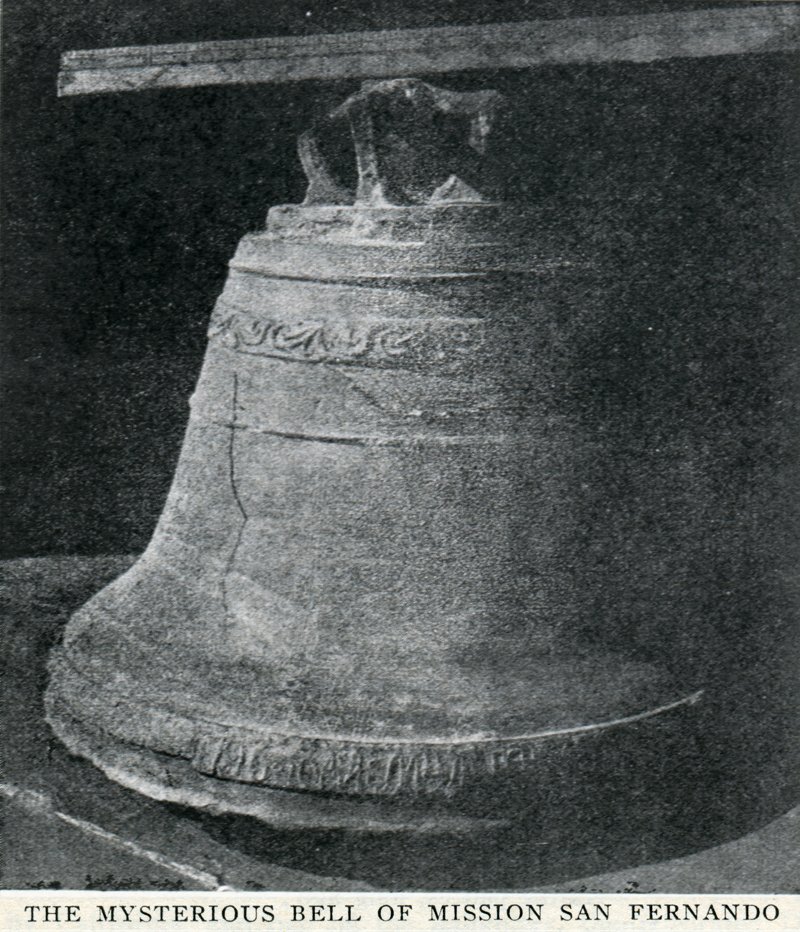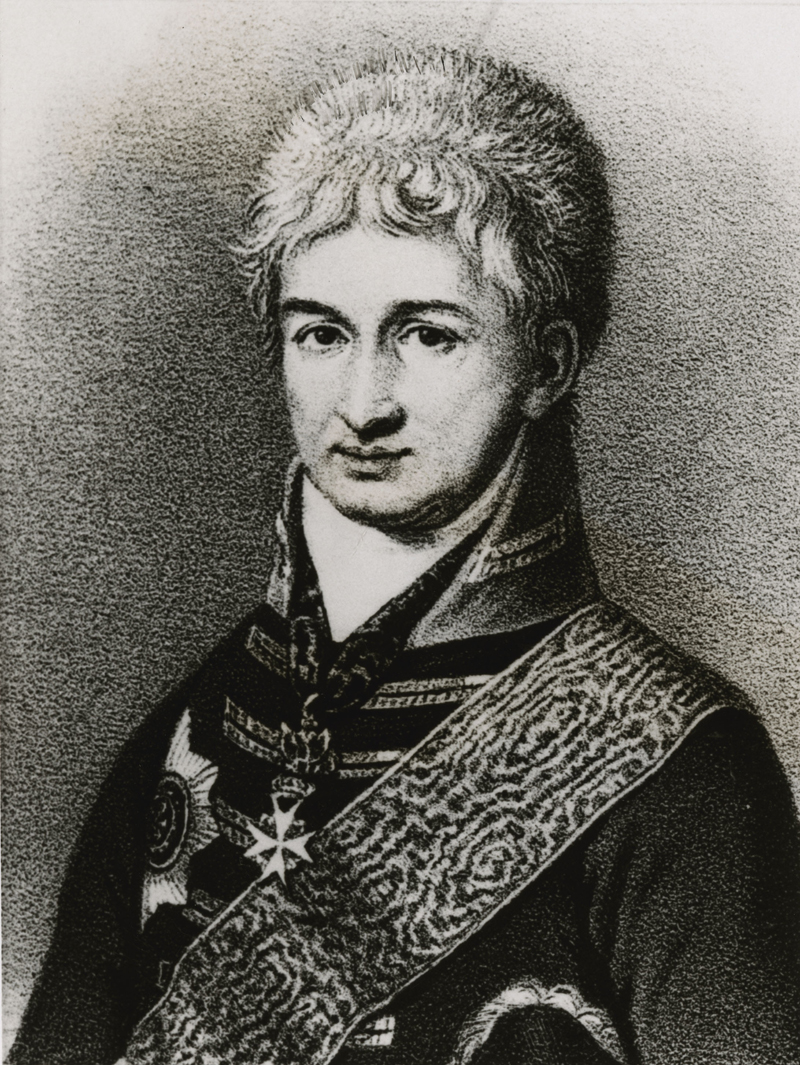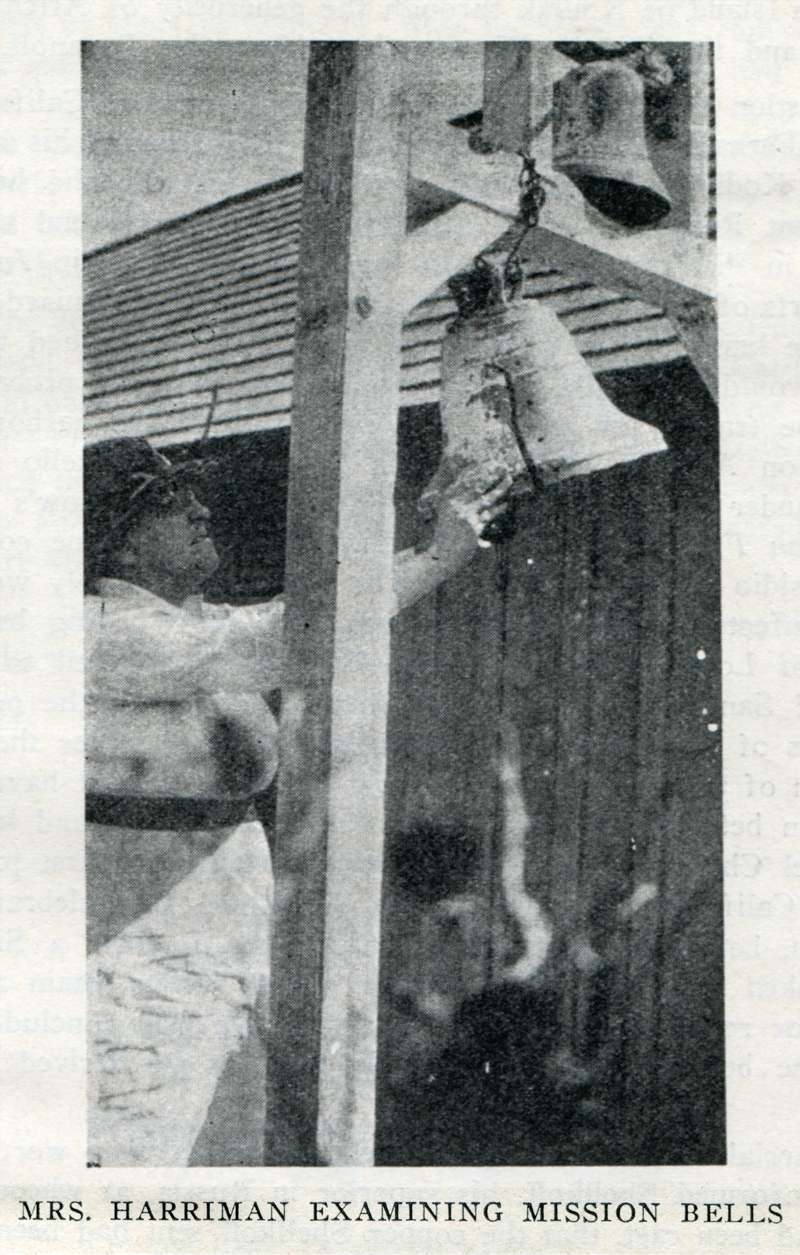|
|
The Mysterious Bell.
[The Russian-Alaskan Bell from Mission San Fernando at Rancho Camulos.]
Fr. Zephyrin Engelhardt, O.F.M.: "San Fernando Rey, The Mission of the Valley," pp. 148-154.
Franciscan Herald Press, Chicago 1927.
|
Webmaster's note. Friar Engelhardt treats Rezanov with benevolence; the reader should bear in mind that Rezanov's true purpose in coming to Alta California was to broker a treaty that would allow Russia to colonize the territory. Spain's refusal to allow its territorial governments to enter into treaties, and Rezanov's untimely death in 1807, thwarted the effort. Nonetheless, Rezanov set the stage for Russian settlement in today's Sonoma County and the establishment of Fort Ross there in 1812, to Spain's chagrin. It should be noted that Engelhardt says the bell discussed here was was removed from the Mission San Fernando and brought to Rancho Camulos about 1860 (coincident with the construction of the Camulos chapel). It might have arrived a bit earlier; according to Smith ("This Land Was Ours," 1977), the bell was present at Rancho Camulos the entire time the Del Valles lived there (pg. 112) and was gone by the time the mission property was inventoried in 1849. Today, the bell is in the collection of the nonprofit Rancho Camulos Museum.
From the inventory drawn up on March 12, 1849[1], it is clear that the belfry of Mission San Fernando then contained one large bell and two smaller bells. There was another in the early days, before the confiscation[2], which had disappeared. It was not discovered until about the summer of 1920, by Mrs. Alice Harriman[3], of Los Angeles. This good lady, deprived by death of her husband soon after marriage, conceived an ardent desire for learning all about the bells in the twenty-one Missions of California. Partly, too, as she acknowledged to the writer with a smile, she made this search her hobby to keep out of mischief. Mrs. Harriman, though not of the same faith with the Mission Fathers, at great expense and more hardship visited and searched every one of the missionary establishments and critically noted the number of bells, their names, their approximate weight, the dates of their arrival, the place of casting, and the names of the founder, along with any story connected with them, for she intended bringing out the facts in book form.[4] Often the persistent searcher would have to overcome great obstacles to reach the cherished objects so as to secure the inscriptions; but nothing deterred her, not even climbing up the interior of the church steeple at Mission San José, which the writer, also in search of the truth about local bells, at another time found it very difficult to ascend, as there were no stairs, but a labyrinth of timbers. Sometimes Mrs. Harriman would hear of the existence of a one-time Mission bell in some out of the way locality. That clue was sufficient for her to risk a long and futile journey. It was in this way that the tireless bell-hunter learnt of the existence of the bell which with its interesting story we are about to describe. Mrs. Harriman related the discovery of this bell in an article published in the Los Angeles Times on July 8, 1923. She had found the bell three years previously in an orange grove of the Camulos Rancho, now the Del Valle Ranch[5]. [Note: Maybe someone stole it and tossed it into an orange grove in 1920, but it was where it belonged in the late 1910s.] After long and minute investigations, Mrs. Harriman came to the conclusion that this bell was not of Spanish origin, which are usually nicely finished. Nor had it come to California from Mexico, Peru, Russia or Massachusetts. The inscription on the Camúlos bell, written in a forgotten language, at last betrayed the secret. It revealed the fact, briefly, that it had been cast at Kodiak, Alaska, in 1796[6]; that it had been traded at San Francisco for food by the Russian Count Nicolai Rezanov[7], and that it had until sixty years ago hung in the famed San Fernando Mission.
When Mrs. Harriman first saw the bell in the orange grove, the inscription could not be made out. The Del Valle family knew only that it had been removed from the Old Mission of San Fernando in order to save it from vandals sixty years ago, i.e., about 1860. Since then it had been exposed to the ravages of the weather on the Del Valle Ranch. A crude cross and the stenciled inscription De Sn Ferno hammered on the bronze surface showed that it had indeed once hung in the San Fernando Mission. Our energetic bell hunter appealed to the Rev. A.P. Kashereroff, curator of the Alaskan Historical Society. On studying the photograph of the bell, the curator deciphered portions of the inscription to read in English: "Island of Kodiak —Alexander Baranoff —Month of January." Two big gaps in the inscription could not be read from the photographs by Dr. Kashereroff. The irrepressible Mrs. Harriman then sought the aid of Dr. Alexis Kall of Los Angeles, a student of the "forgotten" Slavonic language. The complete inscription was thus at last deciphered to read: "1796 —In the Month of January this bell was cast on the Island of Kodiak through the generosity of Arichimandrite Joasaphat and the Church Warden-elect Alexander Baranoff." The question now arose, how did this bell come to California and reach San Fernando Mission? Baranoff in 1805 changed his headquarters from Kodiak to Sitka and most likely brought the bell along.[8] When Count Rezanow [sic] visited Sitka soon after and found the whole settlement in distress for lack of food, he had the ship Juno laden with all sorts of good that would be welcome to the Spaniards in California. He knew that new Missions were being established there and that they would need bells. Hence the Kodiak bell most probably went along to be traded for grain. The Juno entered the harbor of San Francisco on April 8, 1806. Captain José Dario Argüello was then the commander of the port. (See for details of Rezanow's visit our "Mission San Francisco.") In 1806 José Argüello became commander of the presidio at Santa Barbara. The bell most probably went along with the effects of the family by sea. In 1815, having been made governor of Lower [Baja] California, Argüello donated the bell to the new Mission of San Fernando. At all events, perhaps on the petition of the Fathers of San Fernando Mission, which stood under the military jurisdiction of the commander of Santa Barbara, it must have reached the Mission between 1808 and 1815. Captain Argüello and his family were model Christians, one of the boys becoming the first priest produced by California, and one of the daughters, the celebrated Doña Concepcion, being the first native Californian to enter a Sisterhood, may be taken as proof. [9] The captain would hardly retain an article intended for religious purposes. Wherefore we may conclude that he donated the bell to San Fernando as soon as he arrived at Santa Barbara. The material used in casting the bell also deserves a word or two. Baranoff informed Shellkoff, his superior in Russia, at whose instance [sic] the bell had been cast, that the copper Shellkoff sent had been received and that "that Englishman Vancouver" had sent him some tin. Baranoff, most fortunately, also noted that the name of the bell founder was Sapoknikoff. Mrs. Harriman acknowledges that most of her positive information was found in Tekmanieff's History.
Mrs. Harriman completed her self-imposed task of gathering information about the California Mission bells, and had submitted the last chapter for the book which she intended to publish, to the writer for review in order to make sure that everything was historically correct, when she contracted a severe cold. This developed into pneumonia, and, after only six days, carried her noble soul to her everlasting home, the day before Christmas 1925. R.I.P. Good Mrs. Harriman was all the time overflowing with enthusiasm for the bells of the Old Missions. Her happiness was complete, childlike, when she had learnt more details about a bell she had discovered somewhere, and she would hasten to inform the writer and ask what he thought about it. "For I do want to be accurate in these matters," as she would assure the writer, who possesses numerous communications from her on the subject. In one letter she gives vent to her feelings in both prose and poetry as follows: "How one aches to know more details! All along the Camino Real, as I realized more and more what a precious legacy California has in these old bells, did I long to know more of the men who cast them. What vessel brought them? When? How were they handled on their way to each mission? And how and when were they taken from one mission to another (I found this had been done repeatedly)? By whom were they hung? "Ah, how silent the long-past years! How silent the sky-depths, the sea-breadth, the valleys' calm!" THE FIRST BELL "Let me thrill, O years forgotten, "Let me see, O mirror-mountains, "Let me hear, O sky of azure, Meanwhile we were fortunate to obtain more information on the subject from an unexpected source, which the following letter explains in detail. Kodiak, Alaska, May 20th, 1923. Reverend Father Engelhardt, Reverend Sir: About two months ago I called on you at Santa Barbara and asked you in reference to a bell which a Mrs. Harriman had claimed to have found in Southern California, which had been cast in Alaska, and you told me that you had seen nothing in any mission record that had any bearing on the subject. After leaving you in Santa Barbara I found the bell at the chapel at Camúlos Rancho. The bell is of weight of about one hundred pounds and has a delightful timbre, though badly cracked. Around the base of the bell (on one side) it bears this inscription in a mixture of Russian and Slav Russian: "In the year 1796, in the month of January, was cast this bell, on the Island of Kodiak, by order of the Archimandrite Iossaf. Alexander Baranof." On the side of the bell, just above the date 1796, is superimposed a cross which reaches nearly to the top of the bell. It is very well done and is punched in with a sort of punch, the same way that brass work is punched. Now right beneath this cross in large letters which are very prominent are the words: DE Sn FERN Now this would seem to indicate that this bell came to the chapel at Camúlos from San Fernando Mission. It is obvious that the cross and the lettering of Sn FERN was done at the same time and by the same hand. Herewith I beg to hand you a photograph of the bell which shows the Catholic cross on the side of the bell. The bell has been at the Camúlos chapel for at least sixty years, and of course probably much longer. I am very interested in this bell, for it is the connecting link when the Christian Religion completed the circling of the globe. The Greek-Russian from the north meets the Spanish from the south. Now the purpose of this letter is to ask if you can throw any light on when and how this bell got to San Fernando Mission. Perhaps with Rezanov in 1806, when he went to California to get food for the starving Russians of Alaska. He took everything with him that he thought he could trade for grain. Then again a hazy tradition informs me that along about that time there was a Russian settlement on Santa Rosa Island, and that this settlement was massacred, but I can substantiate it nowhere.[10] I am told Holder's "Channel Islands" speaks of this, but I have been unable to find a copy of this book anywhere, old or new. In some book that I picked up twenty years ago I remember reading that Rezenof's [sic] cargo was furs and bells. I can find out what he came north with, but never a word anywhere what was his cargo south. Russian American history speaks not a word of a settlement on Santa Rosa Island, but this is natural because of the Czar's plans on the Pacific Coast were State secrets. Of course I know that Russians and Aleuts were farmed out to captains of American and English ships to hunt sea otter and fur seals on the Californian coast, and in fact as far south as San Quintin in Lower California, but of a settlement south of Fort Ross[11] not a word. This matter is purely a labor of love with me, and if you can aid me any in these matters you will place me under a very great obligation, and if I may serve you in any way I am entirely at your command. I beg to sign myself, very respectfully yours, J.M. Lathrop, Kodiak, Alaska.[12] Webmaster's footnotes. 1. Engelhardt writes (pg. 144): "Early in 1847, owing to the death of Fr. Thomas Esténaga of Mission San Gabriel, Fr. [Blas] Ordaz was directed to withdraw from Mission San Fernando and to take charge of Mission San Gabriel. For want of another priest, however, he retained jurisdiction over his former charge, and occasionally officiated at Mission San Fernando till February 1849. In that month arrived the Rev. Dr. Sebastian Bongioanni, whom the Very Rev. Administrator of the orphaned diocese, Fr. José Maria González Rúbio, O.F.M., under date of January 12, 1849, had appointed Cura of Our Lady of the Angels, Los Angeles, and of Mission San Fernando. At the request of the Very Rev. Administrator, an Inventory was drawn up and signed on March 12, 1849, by Dr. Sebastian Bongioanni and Fr. Blas Ordaz." 2. Secularization and unauthorized sale of the mission by Gov. Pio Pico. 3. Mary Alice Harriman (March 12, 1861 – December 24, 1925) was an author and poet, and a publisher from 1907 to 1913 in Seattle and New York before coming to Los Angeles. 4. Her unpublished manuscript, "The bells of El Camino Real," was compiled posthumously by her friends. The effort to preserve El Camino Real and its bells began in Pasadena in 1892 and became a project of the California Federation of Women's Clubs. After that organization fizzled, the Automobile Club of Southern California took over the project from the 1920s until 1931 when the state took responsibility for the bells. 5. Technically, while it was the Del Valle Ranch in 1923, it was no longer so when Engelhardt published in 1927. August Rubel purchased the property from the Del Valles in 1924. 6. Alaska was a Russian territory until 1867. 7. Nikolai Petrovich Rezanov (1764–1807) was a nobleman and statesman who co-commanded Russia's first circumnavigation of the Earth. He was the mastermind behind the Russian American Company and intended to colonize the entire West Coast of North America for Russia, but he died too soon. 8. Alexander Andreyevich Baranov (1746–1819) was the first chief manager from 1799 to 1818 of the Russian American Company, which purpose was to establish Russian settlements in North America. 9. Yeah, but ... Concepcion's love affair and engagement at age 15 to Rezanov was steeped in controversy. Rezanov, whose former wife died in childbirth, was awaiting either papal dispensation or the tsar's permission to remarry (depending on the version of the story) when he contracted a fever in Siberia and died. After learning of his demise, Concepcion decided to become a nun. 10. Perhaps the writer, Lathrop, is remembering the killing of a group of Russian American Company traders in the Channel Islands by Spanish soldiers in 1815. 11. Fort Ross in modern-day Sonoma County was Russia's main base of operations in Alta California from 1812-1842. 12. J.M. Lathrop was an Alaskan businessman in the early 20th Century, but beyond that, we don't know who he was, and Engelhardt doesn't tell us.
|
Secularization & Sale, 1830s-40s (Engelhardt 1927)
Vischer 1865
Dedication 1925 x4
Bell at Camulos: Alaska Report 1923
Bell at Camulos (News reports 1923)
Bell at Camulos (Engelhardt 1927)
Pre-Restoration
|
The site owner makes no assertions as to ownership of any original copyrights to digitized images. However, these images are intended for Personal or Research use only. Any other kind of use, including but not limited to commercial or scholarly publication in any medium or format, public exhibition, or use online or in a web site, may be subject to additional restrictions including but not limited to the copyrights held by parties other than the site owner. USERS ARE SOLELY RESPONSIBLE for determining the existence of such rights and for obtaining any permissions and/or paying associated fees necessary for the proposed use.









